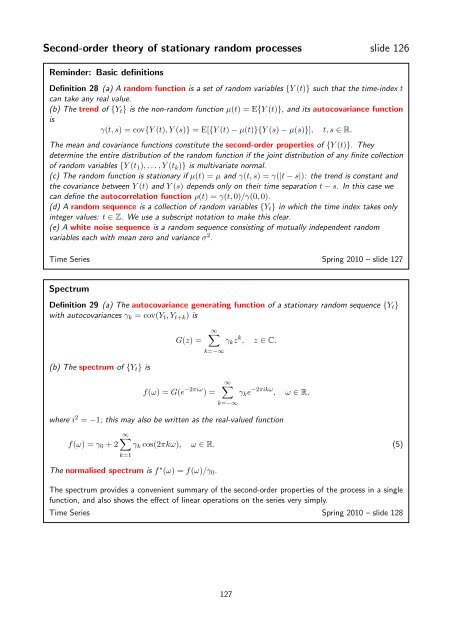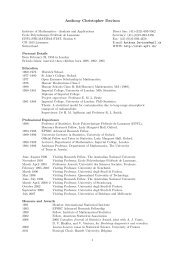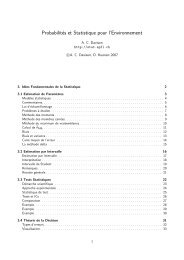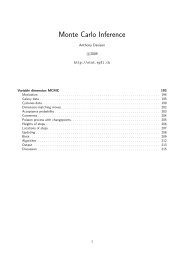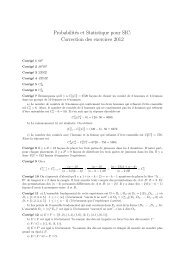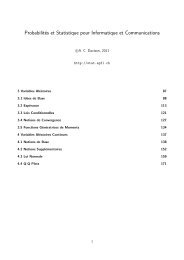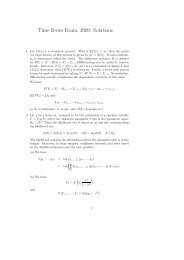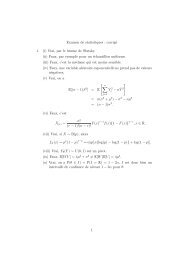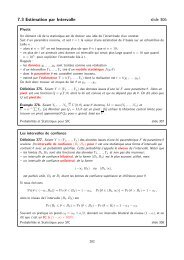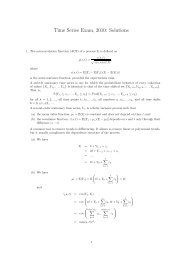Time Series - STAT - EPFL
Time Series - STAT - EPFL
Time Series - STAT - EPFL
Create successful ePaper yourself
Turn your PDF publications into a flip-book with our unique Google optimized e-Paper software.
Second-order theory of stationary random processes slide 126<br />
Reminder: Basic definitions<br />
Definition 28 (a) A random function is a set of random variables {Y (t)} such that the time-index t<br />
can take any real value.<br />
(b) The trend of {Y t } is the non-random function µ(t) = E{Y (t)}, and its autocovariance function<br />
is<br />
γ(t,s) = cov{Y (t),Y (s)} = E[{Y (t) − µ(t)}{Y (s) − µ(s)}], t,s ∈ R.<br />
The mean and covariance functions constitute the second-order properties of {Y (t)}. They<br />
determine the entire distribution of the random function if the joint distribution of any finite collection<br />
of random variables {Y (t 1 ),... ,Y (t k )} is multivariate normal.<br />
(c) The random function is stationary if µ(t) = µ and γ(t,s) = γ(|t − s|): the trend is constant and<br />
the covariance between Y (t) and Y (s) depends only on their time separation t − s. In this case we<br />
can define the autocorrelation function ρ(t) = γ(t,0)/γ(0,0).<br />
(d) A random sequence is a collection of random variables {Y t } in which the time index takes only<br />
integer values: t ∈ Z. We use a subscript notation to make this clear.<br />
(e) A white noise sequence is a random sequence consisting of mutually independent random<br />
variables each with mean zero and variance σ 2 .<br />
<strong>Time</strong> <strong>Series</strong> Spring 2010 – slide 127<br />
Spectrum<br />
Definition 29 (a) The autocovariance generating function of a stationary random sequence {Y t }<br />
with autocovariances γ k = cov(Y t ,Y t+k ) is<br />
(b) The spectrum of {Y t } is<br />
G(z) =<br />
∞∑<br />
k=−∞<br />
f(ω) = G(e −2πiω ) =<br />
γ k z k , z ∈ C.<br />
∞∑<br />
k=−∞<br />
γ k e −2πikω , ω ∈ R,<br />
where i 2 = −1; this may also be written as the real-valued function<br />
f(ω) = γ 0 + 2<br />
∞∑<br />
γ k cos(2πkω), ω ∈ R. (5)<br />
k=1<br />
The normalised spectrum is f ∗ (ω) = f(ω)/γ 0 .<br />
The spectrum provides a convenient summary of the second-order properties of the process in a single<br />
function, and also shows the effect of linear operations on the series very simply.<br />
<strong>Time</strong> <strong>Series</strong> Spring 2010 – slide 128<br />
127


